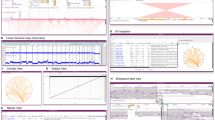Abstract
The proliferation of data from genome sequencing over the past decade has brought us into an era where the volume of information available would overwhelm an individual researcher, especially one who is not computationally oriented. The need to make the bare DNA sequence, its properties, and the associated annotations more accessible is the genesis of the class of bioinformatics tools known as genome browsers. Genome browsers provide access to large amounts of sequence data via a graphical user interface. They use a visual, high-level overview of complex data in a form that can be grasped at a glance and provide the means to explore the data in increasing resolution from megabase scales down to the level of individual elements of the DNA sequence. While a user may start browsing for a particular gene, the user interface will display the area of the genome containing the gene, along with a broader context of other information available in the region of the chromosome occupied by the gene. This information is shown in “tracks,” with each track showing either the genomic sequence from a particular species or a particular kind of annotation on the gene. The tracks are aligned so that the information about a particular base in the sequence is lined up and can be viewed easily. In modern browsers, the abundance of contextual information linked to a genomic region not only helps to satisfy the most directed search, but also makes available a depth of content that facilitates integration of knowledge about genes, gene expression, regulatory sequences, sequence conservation between species, and many other classes of data.
Access this chapter
Tax calculation will be finalised at checkout
Purchases are for personal use only
Similar content being viewed by others
References
Arnaiz O, Cain S, Cohen J, Sperling L (2007) ParameciumDB: a community resource that integrates the Paramecium tetraurelia genome sequence with genetic data. Nucleic Acids Res 35(Database issue):D439–D444
Berriman M, Rutherford K (2003) Viewing and annotating sequence data with Artemis. Brief Bioinform 4(2):124–32
Brendel V, Kurtz S, Pan X (2007) Visualization of syntenic relationships with SynBrowse. Methods Mol Biol 396:153–63
Crabtree J, Angiuoli SV, Wortman JR, White OR (2007) Sybil: methods and software for multiple genome comparison and visualization. Methods Mol Biol 408:93–108
Curwen V, Eyras E, Andrews TD, Clarke L, Mongin E, Searle SM et al (2004) The Ensembl automatic gene annotation system. Genome Res 14(5):942–50
Dowell RD, Jokerst RM, Day A, Eddy SR, Stein L (2001) The distributed annotation system. BMC Bioinformatics 2:7
ENCODE Consortium (2004) The ENCODE (ENCyclopedia Of DNA Elements) Project. Science 306(5696):636–40
Faga B (2007). Installing and configuring CMap. Curr Protoc Bioinformatics Chapter 9: Unit 9.8
Flicek P, Aken BL, Beal K, Ballester B, Caccamo M, Chen Y et al (2008) Ensembl 2008. Nucleic Acids Res 36(Database issue):D707–D714
Gans JD, Wolinsky M (2007) Genomorama: genome visualization and analysis. BMC Bioinformatics 8:204
Hsu F, Kent WJ, Clawson H, Kuhn RM, Diekhans M, Haussler D (2006) The UCSC Known Genes. Bioinformatics 22(9):1036–46
Karolchik D, Hinrichs AS, Furey TS, Roskin KM, Sugnet CW, Haussler D et al (2004) The UCSC Table Browser data retrieval tool. Nucleic Acids Res 32(Database issue):D493–6
Karolchik D, Kuhn RM, Baertsch R, Barber GP, Clawson H, Diekhans M et al (2008) The UCSC Genome Browser Database: 2008 update. Nucleic Acids Res 36(Database issue):D773–9
Kent WJ, Sugnet CW, Furey TS, Roskin KM, Pringle TH, Zahler AM et al (2002) The human genome browser at UCSC. Genome Res 12(6):996–1006
Kent WJ, Baertsch R, Hinrichs A, Miller W, Haussler D (2003) Evolution’s cauldron: duplication, deletion, and rearrangement in the mouse and human genomes. Proc Natl Acad Sci USA 100(20):11484–9
Lewis SE, Searle SM, Harris N, Gibson M, Lyer V, Richter J et al (2002) Apollo: a sequence annotation editor. Genome Biol 3(12):RESEARCH0082
Montgomery SB, Astakhova T, Bilenky M, Birney E, Fu T, Hassel M et al (2004) Sockeye: a 3D environment for comparative genomics. Genome Res 14(5):956–62
Pruitt KD, Tatusova T, Maglott DR (2007) NCBI reference sequences (RefSeq): a curated non-redundant sequence database of genomes, transcripts and proteins. Nucleic Acids Res 35(Database issue):D61–5
Stajich JE, Block D, Boulez K, Brenner SE, Chervitz SA, Dagdigian C et al (2002) The Bioperl toolkit: Perl modules for the life sciences. Genome Res 12(10):1611–8
Stein LD, Mungall C, Shu S, Caudy M, Mangone M, Day A et al (2002) The generic genome browser: a building block for a model organism system database. Genome Res 12(10):1599–610
Wang H, Su Y, Mackey AJ, Kraemer ET, Kissinger JC (2006) SynView: a GBrowse-compatible approach to visualizing comparative genome data. Bioinformatics 22(18):2308–9
Wheeler DL, Barrett T, Benson DA, Bryant SH, Canese K, Chetvernin V et al (2007) Database resources of the National Center for Biotechnology Information. Nucleic Acids Res 35(Database issue):D5–12
Author information
Authors and Affiliations
Corresponding author
Editor information
Editors and Affiliations
Rights and permissions
Copyright information
© 2009 Springer Science+Business Media, LLC
About this chapter
Cite this chapter
McKay, S., Cain, S. (2009). Genome Browsers. In: Edwards, D., Stajich, J., Hansen, D. (eds) Bioinformatics. Springer, New York, NY. https://doi.org/10.1007/978-0-387-92738-1_3
Download citation
DOI: https://doi.org/10.1007/978-0-387-92738-1_3
Published:
Publisher Name: Springer, New York, NY
Print ISBN: 978-0-387-92737-4
Online ISBN: 978-0-387-92738-1
eBook Packages: Biomedical and Life SciencesBiomedical and Life Sciences (R0)




